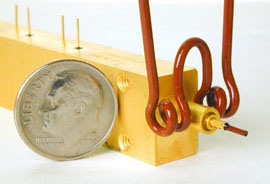Improves maintainability without the need for a soldering iron

IH soldering is a process in which a precise electromagnetic field is used to heat two or more electrically conductive materials in order to join them with a filler material that melts at a temperature below the melting point of the joined materials.
Video: IH soldering application examples
Soldering process
Soldering differs from brazing because it is performed at lower temperatures. When compared to brazing, soldering may have a slightly weaker joint, but that can be preferable for some applications like small components.
Soldering differs from welding because it does not involve the melting of joints.
There are a number of benefits that come with using IH for soldering applications.
Common problems
- Not very strong
- Less resistant to fatigue
- Can be used in temperatures up to 170°C
Tips for good soldering
- Surface cleanliness is important
- Make the temperature of the connection point of both metals the same at the same time
- If the temperature is too high, it will not result in a strong solder.
- Instead of wire solder or bar solder, place solder that has been shaped into the shape of the joint before heating.
Advantages of IH
Fast heating cycles
First and foremost, IH is a rapid method of heating. Depending on the work piece and system being used, the process can take just seconds. So if you're hoping to solder metals quickly, induction is a great choice.
Reduced error potential
IH is a precise method of heating, which makes it a great method for soldering. Once the process is set up, you can expect the same result time after time. It helps minimize the odds of inconsistencies which you might see with a soldering iron or torch.
Enhanced control
IH soldering enables you to control the process thanks to induction's precise heating while also avoiding thermal stress. Ultimately, the efficiency of an IH system for a specific application depends on four factors:
- The characteristics of the part itself
- The design of the inductor
- The capacity of the power supply
- The amount of temperature change required for the application
Understanding the basic information about IH soldering can help you determine whether or not it's suitable for your needs, so next time you're asking yourself, "why should I use IH soldering?" you'll have some background info.
